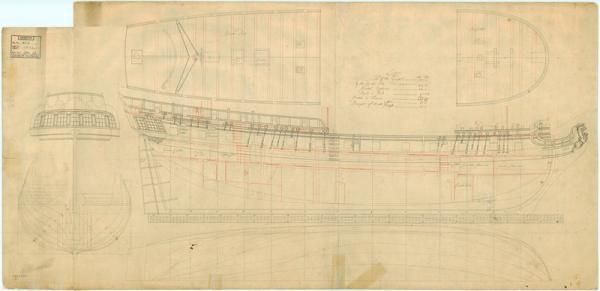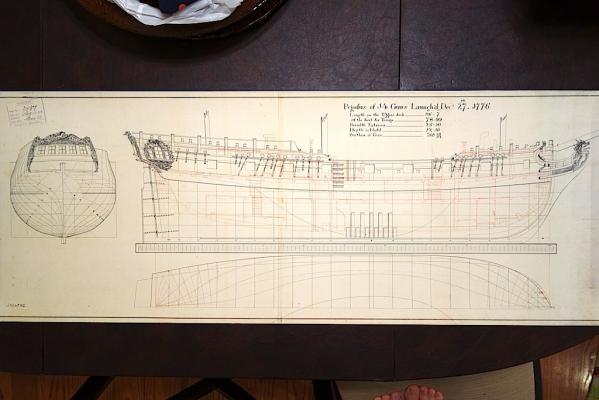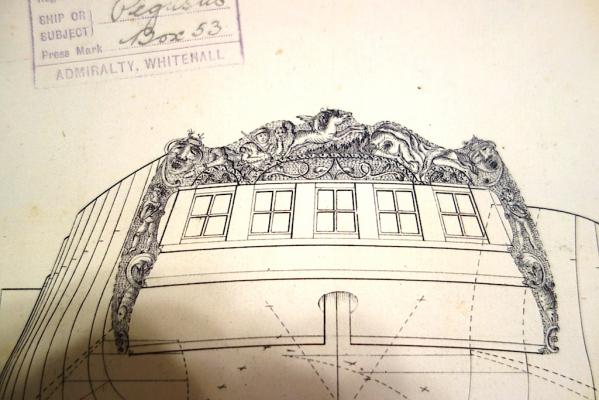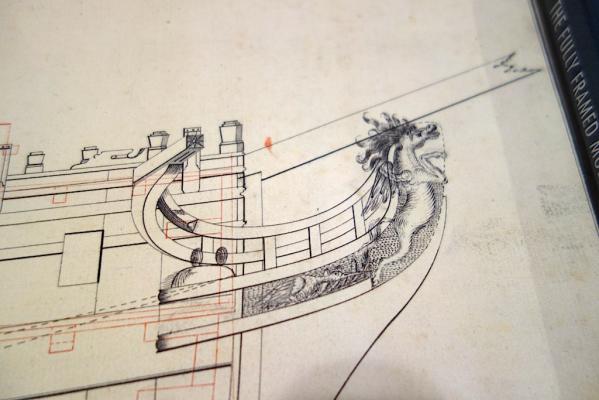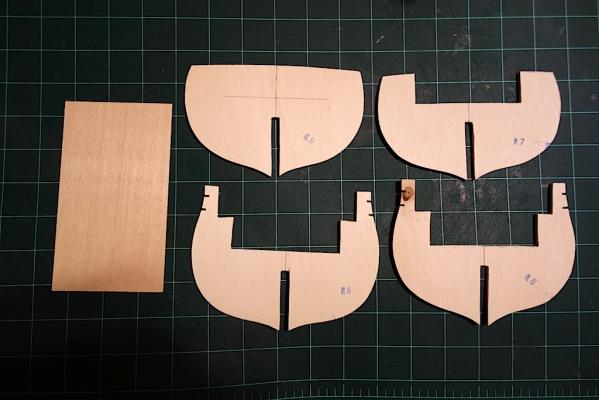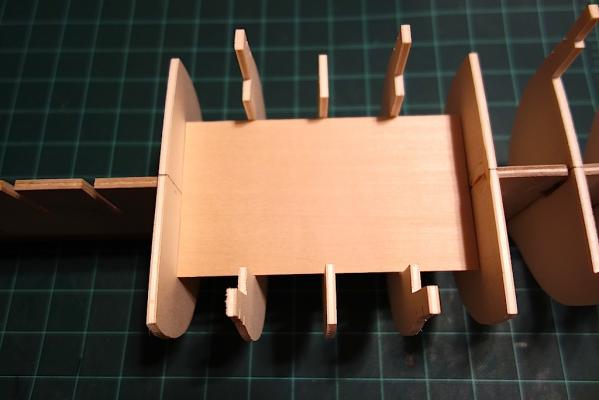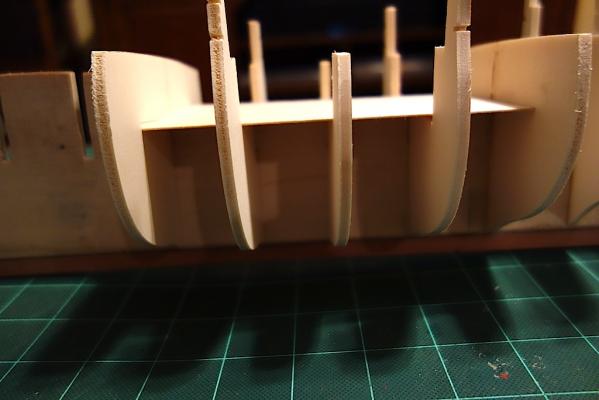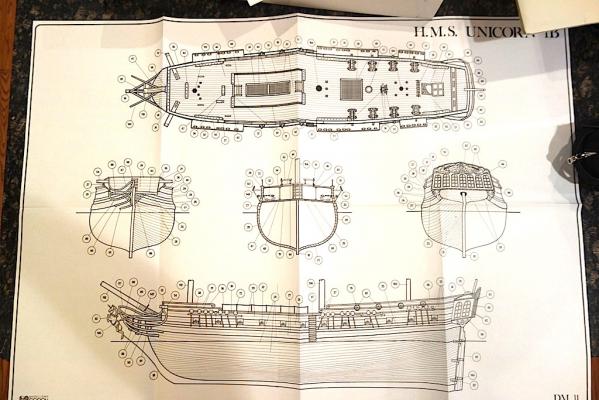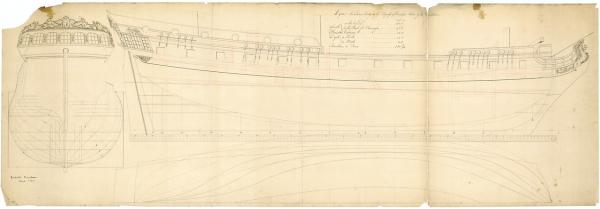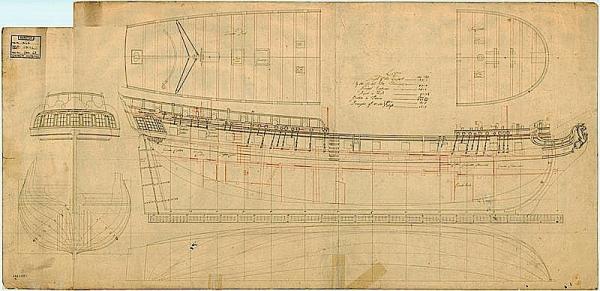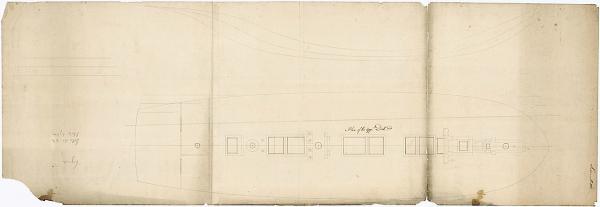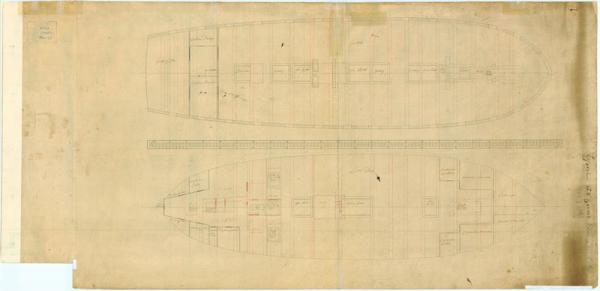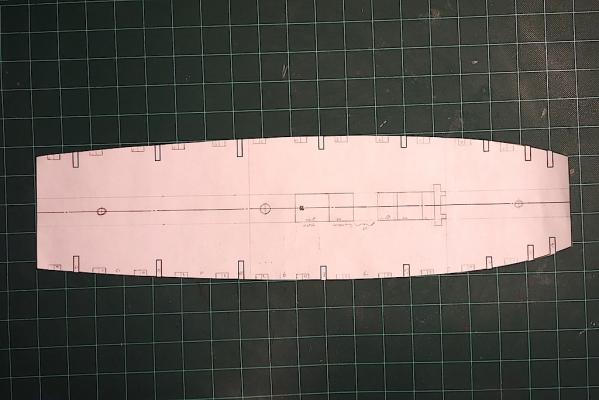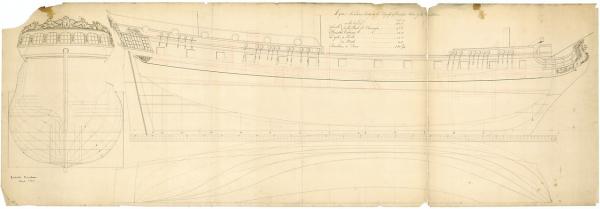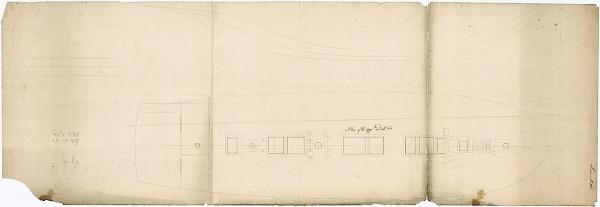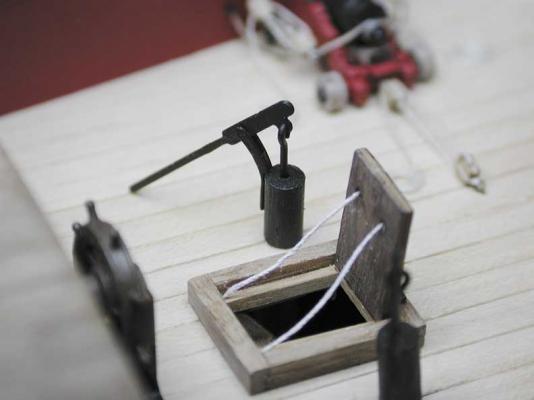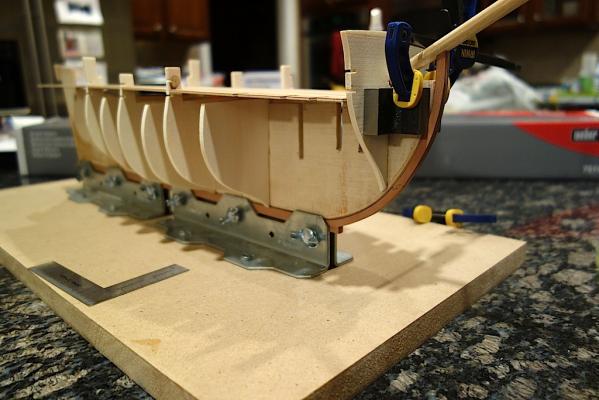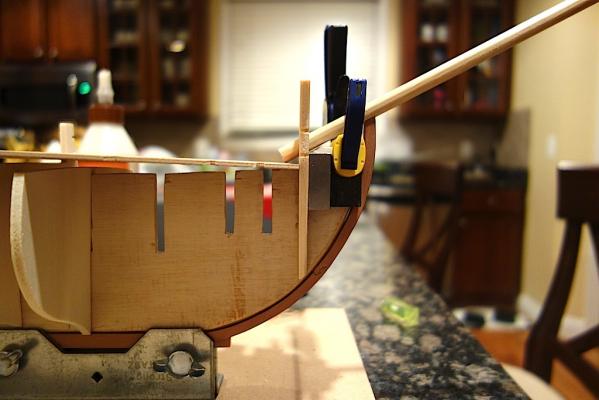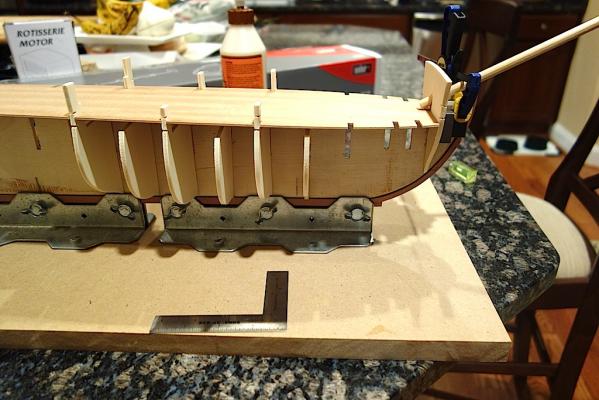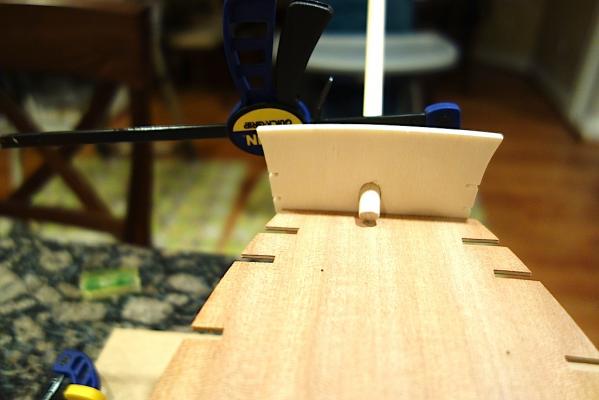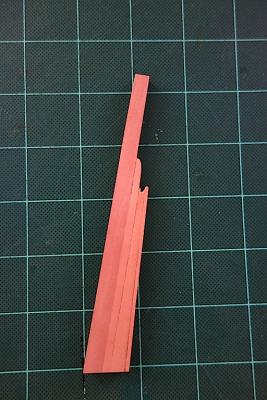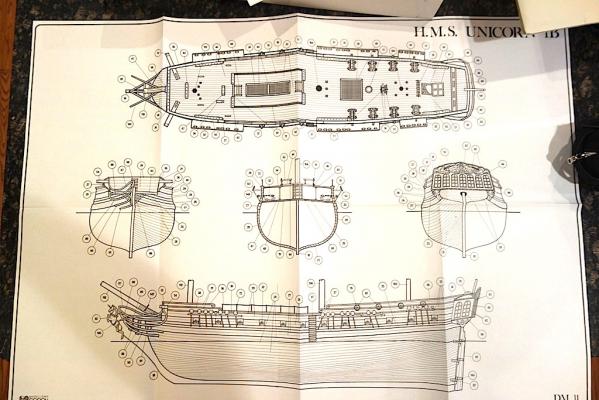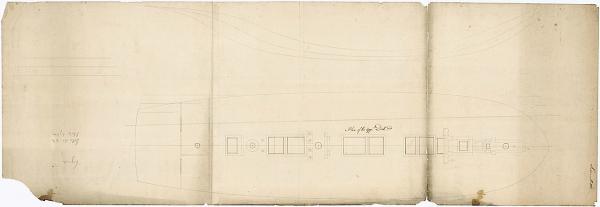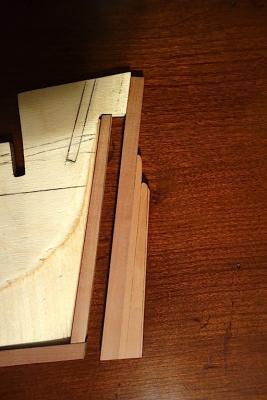-
Posts
4,540 -
Joined
-
Last visited
Content Type
Profiles
Forums
Gallery
Events
Everything posted by Landlubber Mike
-
Hi Ian, thanks for the thoughts. A collateral benefit of going the Lyme route and having a unique build is that my build won't be compared to the gorgeous Unicorn builds out there I did see that about the external differences. The rails might be slightly different, with the ends of the railings on the Unicorn slightly more decorative. Interestingly, it looks like big middle stern gallery window might pop up onto the quarterdeck, or end just at it. Also, in the two profile plans, the second has what looks like two portholes in the transom, whereas the first plan, from the transom decoration, doesn't look like it would accommodate two portfolios. On the plans below, do you know what the rail looking thing is that extends above the transom in the stern view? It looks like railings, but I think the bulwark sides of the quarterdeck are solid given that the portholes are shown.
-
The beakhead is probably the only reason that I'd stick with the Unicorn. Unfortunately, the "Lyme Class" only consisted of two members - the Lyme and the Unicorn. The design was successful however, and there were a number of close descendants of the class, including the Guadaloupe and the Pandora. You can probably build any of those ships off the Corel kit with relatively few modifications.
-
Hi Jason, Going with the replacement is a good idea. I know some people are able to use the soaking and weighting technique, but I would be very nervous that the keel would have a tendency to warp over time. If you pay good money for a kit, the least you should expect is a flat keel in my opinion. Glad to hear that Caldercraft is standing by their product. Interesting on the by air versus by sea results. On my Unicorn, I bought a couple of sheets of plywood from Micro Mark to cut out a new keel. Both the sheets, even at 5mm, were significantly warped, worse than the kit keel. I then bought a package of 5 sheets from Hobbylinc (maybe Revell brand, I forget), and 3 of the 5 had a decent sized warp to them, and really only one was workable. MDF might be a better way to go.
-
Thanks Ian. So far everything is working out nicely, but before I get too excited, I have to see how well I pull this all off I posted this on my Pegasus log, but I thought I would post it here as well to get your thoughts and thoughts from others that have been following my Unicorn log. Recently, I've been strongly considering building this kit as the Lyme, rather than the Unicorn. There are a few reasons for this: (1) the stern and galleries would be much easier to execute from scratch I think, and in my opinion, look nicer than that of the Unicorn; (2) the figureheads would take about the same amount of carving and skill, and (3) the quarterdeck bulwarks would be easier to execute with the full portholes, and again, would probably look nicer than the Unicorn. There are some minor differences like the railings, but I think the main consideration is whether I want to build a ship with a beakhead bulkhead (the Unicorn), or go with a rounded bow like the Lyme. I think the beakhead is a cool feature, but I'm not wedded to it as the stern transom and galleries, and the figurehead, are all more interesting to look at. Just curious what you and others think on this change of plans. I still have a little time to think about it, but probably need to come to a decision before the first planking so that I can frame out the rounded bow if I went the Lyme route.
-
Ian - with the amount of crisp detail on the plans, I might look into buying the Lyme plans. Since I'm pretty much scratch building most of the Unicorn anyway, recently I've been considering converting the Unicorn to the Lyme as: (1) the stern and galleries would be much easier to execute from scratch I think - and in my opinion, look nicer than that of the Unicorn; (2) the figureheads would take about the same amount of carving work and skill; and (3) the quarterdeck bulwarks would be easier to execute with the full portholes, and again would probably look nicer than the Unicorn. There are some minor differences like the railings, but I think the main consideration is whether I want to build a ship with a beakhead bulkhead (the Unicorn), or go with the rounded bow like the Lyme. I think the beakhead is a cool feature, but I'm not wedded to it. If you had the choice, what would you do?
-
B.E., thanks very much for the recommendation on the plans. They are gorgeous like you say. I'll probably frame mine as well after my build is completed, so if the model stinks, at least I'll have nice artwork that people can look at I'll have to take a closer look at the stern carvings. I remember reading about your concerns over the Norman knights. The figurehead to me looks really wild - I might have to start practicing carving now, so that in a few years, I can carve something similar. Alistair, the plans are really fantastic. I'm not sure what they are printed on, but it's sort of a laminated paper so they are very sturdy. As B.E. notes, they are of nice decorative quality as well and can be displayed as artwork -- although, take my opinion for what you paid for it as my sense of what is "art" isn't all that great I remember seeing someone post the Fly plans on here, and they looked to be just as good as the Pegasus plans.
-
A little present arrived in the mail today - plans of the Pegasus from the NMM! The plans are really gorgeous and show a lot of detail. I know some people had some issues ordering plans from there, but my transaction went very smoothly. Interestingly, the stern figures as well as the figurehead are quite different than the kit. Not sure what that means for my build, but the figurehead looks pretty wild relative to the kit figurehead. Don't mind my toes in the first picture
-
One point of caution for future Unicorn builders -- make sure you check the symmetry of your bulkheads. The bulkheads are not laser cut, and a couple of them were not symmetrical. So, I used my disc sander to get them in better shape. It's another very annoying thing about this kit. Not only are the plans off, but the bulkheads are not symmetrical
-
With the modified upper deck waist area to include companionways, I needed to build a sub/false lower deck. This meant cutting out a section of the keel where I could drop in the lower deck. ZyXuZ did something very similar on his Unicorn build. Based on my planned arrangement for the waist area, the area between bulkheads 5 and 9 needed to be removed. After marking out the section to be cut, I used a Dremel with a cut-off wheel to remove the sections of the keel. The only difficulty i ran into was the fact that I had already glued in bulkhead 5. It was a pretty easy fix in that I got as close to the after face of the bulkhead with the cut-off wheel, then used a sanding drum on the Dremel to remove the remainder of the keel that was along the bulkhead's after face. I then used my scroll saw to cut out a profile into bulkheads 6 through 8, cut out a lower deck template, and used my thickness sander to get the template thinned down. Here is what the assembly will look like after dry fitting the bulkheads and the false deck template. I'm adding frames that will sit along the after face of bulkhead 5 and fore face of bulkhead 9 to help seat the deck template (not pictured).
-
I spent time this weekend planning out the waist area of the upper deck. The kit plans call for a narrow waist, with two sets of double gratings in the middle of the waist: After researching and conferring with my fellow Unicorn builders, the consensus is that the waist on the ship should be a lot more open. That means reconfiguring the hatches and companionways. Thankfully, plans of the Lyme, the Unicorn's sister ship of the Lyme class, are on the NMM site and provide plenty of detail. Also very helpful is the fact that these plans are very close to the Pandora plans, that can be found in the AOTS book. One interesting thing to point out is that on the second set of plans below, the plans show the tiller on the quarterdeck, which means that Ian was spot on as always in saying that the tiller had to be on the quarterdeck. So, here is where I came out on the waist area of the upper deck. Essentially, moving aft from the riding bitts, you have a a companionway and two gratings, followed by empty deck space, and then another two gratings. I still need to add the various deck items around the main mast, but you can see the general configuration. Interestingly, there's a very steep set of stairs just aft of the riding bits on the Lyme plans. The Pandora omits this set of stairs, but adds them one level lower (lower deck to orlop deck). On my plans, I've drawn the gratings with a width of 25mm, which was shamelessly borrowed from Ian's deck calculations (he I believe used 24.5, but I rounded up). The width might change slightly depending on how the coamings line up with the deck planking. In terms of their length, I scaled up the Lyme plans as best I could. As I mentioned earlier to Ian, surprisingly, the Corel plans actually matched up with the upper deck template. Even more surprisingly, in scaling up the Lyme plans and drawing the gratings and companionways onto the Corel upper deck template plan, the Corel plans seemed to be actually quite accurate relative to the Lyme plans, as well as the plans for the Pandora and the Guadaloupe, close descendents of the Unicorn.
-
Very nice work Bill. Amazing progress given that the build was dormant for 21 years
- 335 replies
-
- Constitution
- Mamoli
-
(and 3 more)
Tagged with:
-
Really amazing work Richard. Thanks very much for sharing. I hope my fifth build looks as nice as your first
- 227 replies
-
- syren
- model shipways
-
(and 1 more)
Tagged with:
-
Very nice work Peter. This is bringing back flashbacks of when I added sails to my Badger - some good memories, some not so good What I remember is how much time all this detail takes to do, and yours came out very nicely. I'll have to try out your approach when I add sails to my build. Alistair, I'm a big fan of adding sails. With your attention to detail and precise work, your Fly would look fantastic with sails. It took me a lot of time to research and experiment adding them to my Badger, but I think it was all very worth it if not for the aesthetics, but also to better understand how sails operated.
- 431 replies
-
- pegasus
- victory models
-
(and 1 more)
Tagged with:
-
Hi Denis, very very nice work on the sails. Having gone through sailmaking on my Badger, I know how much time and effort it takes to add them to the model. I love the look and color of them - very well done! Can you also send me a PM of what material you used? I used the thinnest cotton fabric I could find at my local fabric shop, but it was probably a bit too thick for my liking.
- 555 replies
-
- sovereign of the seas
- mantua
-
(and 1 more)
Tagged with:
-
Hi John, very nice work on the galleries. They came out very nicely and look much better than the cast metal parts. I'll be very interested to follow your work on installing the false deck. I haven't quite figured out how, and in what way, I want to raise/re-angle the quarterdeck on my build. Since I'm planning on avoiding paint but will likely stain the bulwarks and cannon carriages red, I'm worried that the color on the walnut (bulwark planks and cannon carriages) won't match the color on the plywood uprights that serve as support for the quarterdeck frames -- so I will have to remove them anyhow. What I'm thinking I'll do is install the bulkheads as per the plans, add the first planking, then remove the uprights and replace them with walnut uprights to serve as the new supports. I can build the walnut uprights to the proper height to raise the quarterdeck level, which hopefully should do the trick. If you're interested, I spent some time studying the Chapman plans and came up with new upper deck and quarterdeck lines at the post below. The only modification I would probably make to my diagram is to run the line of the two decks closer to the Corel plans from about the last gunport to bulkhead 16 -- essentially to keep the upward sweep of the decks as you move towards the stern. http://modelshipworld.com/index.php?/topic/6223-hms-unicorn-by-landlubber-mike-corel-scale-175-1748-1771/?p=202411
-
Love the floor and great cabin Augie. I better not show my wife or she may ask me to hire you to put in new floors in our house
- 2,191 replies
-
- confederacy
- Model Shipways
-
(and 1 more)
Tagged with:
-
Hi Kester, thanks very much for your thoughts. I was hoping that you would weigh in In terms of the companionways versus the hatches, I'm fairly certain that the two I identified are the companionways. I used the highly scientific approach of opening both pictures on my computer, put one on top of the other, and expanded them until the masts lined up. Then used a piece of paper as a straight edge to draw a vertical line from the stairs to the respective openings All that makes a lot of sense, and is what my other go to person, Ian, said The two companionways seem a bit awkward, but with tight quarters, nothing should surprise me I suppose. The Unicorn was also based off a French ship (the Tygre), so maybe that explains things as well You are indeed correct that the Pandora and Guadaloupe were later designs off the Lyme class. Thank you!
-
Hi everyone, While fitting the bulkheads to the keel on my Unicorn build, I'm designing the upper deck layout of the hatches and companionways, etc. Corel's plnas call for a relatively closed waist with a series of contiguous hatches. I will open the waist, and modify the arrangement of the upper deck to also include companionways. Fortunately, I was able to download from the NMM the profile plan and upper deck plans of the Lyme, the Unicorn's sister ship, which gives the details needed. As you can see, there are two sets of stairs running down from the upper deck to the lower deck in the waist area. The first is a very steep set of stairs just aft of the riding bitts. The second is a main set of stairs running just ahead of the grating in front of the main mast. I'm a bit confused on both sets of stairs, and was hoping to get some input from folks on here. 1. First stairs. For the steep set of stairs running down and forward that are just aft of the riding bitts, how would the companionway work so that it didn't interfere with the riding bitts? Would there be stanchions and railings around it like the other companionways? It seems like it stanchions and railings would run too close to the riding bitts. Instead, I could always add a hatchway like on the Badger (pictured below), though it probably suffers from the same issue of bumping against the riding bitts. 2. Second stairs. On the second set of stairs in front of the main mast, the stairs go down and towards the bow. So, to go onto that set of stairs, you would have to step on the gratings that are immediately behind them. That doesn't strike me as right, or even safe for crew. Do these plans make sense? In looking at plans for similar ships like the Pandora and the Guadeloupe, the upper deck did not incorporate the first set of stairs, and the second set are not contiguous with the gratings behind them. I could go that route, but I'm trying to build the Unicorn as accurately as possible even if it means adding these odd companionways. Thanks very much in advance!
-
Thanks Augie! Ian, thanks very much for your thoughts. I've been meaning to bring this issue up with you, as well as with Joe who also identified the issue. It's interesting, -- I took a look at the Pandora diagrams, and the forecastle area bulkheads flare out to the sides consistent with the Unicorn plans. I believe the Blandford does as well. When I look at Chapman, it's unfortunate that lines Q, O and L don't extend all the way up - they are completely vertical up to the point where they end, but I wonder if extended all the way up, if Chapman would have them flare out? I'll need to think about it a little more. The Pandora lines gave me comfort that Corel could have been accurate here (plus, it adds some more curves to the hull which might look aesthetically nicer), but if I'm mistaken, I would love to know. I'm sure it makes things a little more complicated with the planking and detail items, but with all the other modifications I'm making, the curved bulkheads seem on the easier side
-
Here's a quick update on where I am. Despite my frustrations with the plans, I've plugged along and made some progress. Even though the plans disagree with each other and the kit parts, the kit parts themselves fit together very nicely. For example, the false keel, bulkheads and upper deck template all fit very well together. I started to glue in the bulkheads. The pictures show the first one being fitted. So far I've fit up to bulkhead 5, and have 11 more to go. I'm not going to use bulkhead 17, but instead, to get a curved, modified transom, will frame the stern using frames attached to either bulkhead 15 or 16. I used clamps and angle squares, levels across the bulkheads, etc., along with the upper deck pattern, to make sure that everything was square (the deck pattern isn't sitting fully in the pictures, but it does sit fully). My build board is a bit unorthodox as you can see. It's what I used for my Badger. At the time, I didn't have power tools, and was worried about finding long, perfectly straight pieces into which I could insert the keel. So, instead I used these angle brackets - one side is fixed to the MDF board, the other floats - with the two sides attached via a nut and bolt. I guess the good thing about this set up is that it is adjustable, so I was able to adjust the width between the brackets to accommodate the wider keel of the Unicorn. It's not pretty, but it seems to work. I'm pausing on adding the other bulkheads at this time, as I plan on adding a false lower deck in the waist accommodate stairs from the upper deck to the lower deck. As you can see from the plans below, the plans have a long double-grating at the waist. Instead, I am going to modify the upper deck hatchways, etc. (as well as the deck arrangements for the forecastle and quarterdeck) by using the plans for the Lyme, the sister ship of the Unicorn as you can see in the second picture: In the meantime, I modified the rudder a bit to make it more like the Pandora rudder. The Blandford rudder shape was, well, a little bland for me So, I sanded off the back (I think that is what the aft-most piece is called), and added a new one that was longer and a big thicker. I then shaped the area around where the spectacle plate will go. I think it looks a little better now, or at least, less "bland" Before and after pictures below.
-
Very nice Ulises. I bet having that behind you makes you feel a lot better. I think I would have gone crazy if I had to line up all those gunports
- 786 replies
-
- Royal Louis
- Finished
-
(and 1 more)
Tagged with:
-
Thanks for sharing this. Very interesting! I might have to try this approach with my garden hose, which is always getting twisted and in knots
-
On my Badger, I did sails in the following order: 1. standing rigging; 2. attached the sails to the yards; 3. attached the yards to the masts. Attaching sails is very fiddly work. I don't know how you could ever attach them to the spars after the spars were already attached to the masts.
About us
Modelshipworld - Advancing Ship Modeling through Research
SSL Secured
Your security is important for us so this Website is SSL-Secured
NRG Mailing Address
Nautical Research Guild
237 South Lincoln Street
Westmont IL, 60559-1917
Model Ship World ® and the MSW logo are Registered Trademarks, and belong to the Nautical Research Guild (United States Patent and Trademark Office: No. 6,929,264 & No. 6,929,274, registered Dec. 20, 2022)
Helpful Links
About the NRG
If you enjoy building ship models that are historically accurate as well as beautiful, then The Nautical Research Guild (NRG) is just right for you.
The Guild is a non-profit educational organization whose mission is to “Advance Ship Modeling Through Research”. We provide support to our members in their efforts to raise the quality of their model ships.
The Nautical Research Guild has published our world-renowned quarterly magazine, The Nautical Research Journal, since 1955. The pages of the Journal are full of articles by accomplished ship modelers who show you how they create those exquisite details on their models, and by maritime historians who show you the correct details to build. The Journal is available in both print and digital editions. Go to the NRG web site (www.thenrg.org) to download a complimentary digital copy of the Journal. The NRG also publishes plan sets, books and compilations of back issues of the Journal and the former Ships in Scale and Model Ship Builder magazines.



